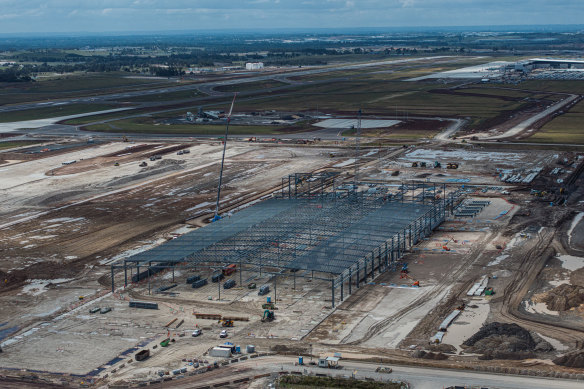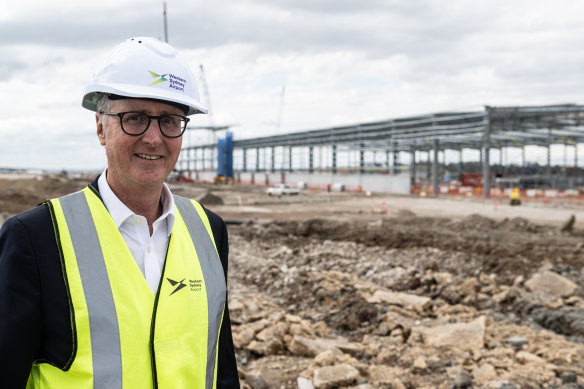On land that was once dotted with farms and market gardens, the skeleton of a giant air cargo warehouse rises out of rain-sodden earth at the southern end of Sydney’s new international airport.
“Only a few months ago this was just fields,” said Western Sydney Airport chief executive Simon Hickey, pointing at the first of five state-of-the-art warehouses to be built. “They’ll look more like a modern Amazon facility than they would an old cargo shed of the 1950s.”

The first of five giant warehouses in the air cargo precinct. The runway and passenger terminal are in the background.Credit: Nick Moir
In a little over two years, large cargo planes will begin parking at eight bays – referred to as “hard stands” – in front of the warehouses, loading high-value goods ranging from flowers and seafood to pharmaceutical goods destined for markets in Asia and further abroad.
The first will be dedicated freighter aircraft from Qantas and Menzies Aviation, one of the world’s largest air freight operators, after the companies both signed deals to operate warehouses at Western Sydney Airport’s cargo precinct.
“It will help farmers who can get produce out to Asia – 24 hours from picking to plate,” said Hickey, a former head of Qantas’ international operations.
Qantas has purchased six new A321 and two A330 freighter aircraft, and many of those that will fly out of the airport will be carrying parcels for Australia Post.
In an expansion of the original plans, Western Sydney Airport has raised $805 million in debt financing, the majority of which will be spent on building the cargo precinct, and the remainder on a business park at the northern end of the airport. The warehouses are set to become highly automated as conveyor belts shift parcels and other goods.
It is a sign of how quickly the airport is taking shape as construction workers and the federal entity overseeing it prepare for the first passenger planes taking off in late 2026.
If they come by car, passengers will arrive at the terminal via the new M12 motorway to the airport’s north, while trucks will access the new cargo hub from the southern end via the Northern Road.
“The best design and safety in design is to make sure that your cargo precinct is not mingling with passenger cars,” Hickey explained.

Western Sydney Airport chief executive Simon Hickey on the site of the new freight hub.Credit: Nick Moir
The extra funding for the expanded freight precinct increases the investment in the airport to $6.1 billion, from $5.3 billion.
Western Sydney Airport’s cargo hub will initially have capacity to handle 220,000 tonnes of freight a year, increasing the city’s air cargo capacity by a third. However, the new airport has room to grow to 1.8 million tonnes of freight over the coming decades.
Air freight is typically high-value goods such as semiconductor chips or electronic componentry and, in other cases, perishable products such as fresh strawberries, which are picked one day and on a plate thousands of kilometres away the next.
The cargo deals come weeks after Singapore Airlines became the first international carrier to confirm flights to the new airport when it opens in 2026. Last year, Qantas and budget offshoot Jetstar committed to basing 15 domestic aircraft at the new airport within a year of its opening, flying to destinations such as Melbourne, Brisbane and the Gold Coast.

An artist’s impression of the massive air cargo hub planned for Western Sydney Airport.Credit: Western Sydney Airport
The new airport’s curfew-free status will give it an advantage over Sydney Airport, which has a flight curfew between 11pm and 6am. An area zoned for agribusiness is also located on the opposite side of the Northern Road to the new airport’s freight precinct.
Qantas international and freight chief executive Cam Wallace said the new cargo facility would help it meet growing demand for e-commerce and complement the airline’s existing operations in Sydney and across the country.
“[The new airport] has some big strategic advantages for freight operations, particularly with overnight flights, which will help ensure parcels and other critical freight can be delivered around Australia as quickly as possible,” he said.
About 2.5 million people live within about an hour of the new airport at Badgerys Creek, making it the third-largest catchment for an Australian airport.
Built on a 1780-hectare site, it will be able to handle 10 million passengers a year when it opens, making it a similar size to Adelaide Airport. However, it has been designed to grow to 82 million passengers annually by the 2060s, making it the size of London’s Heathrow Airport today.
Its 3.7-kilometre runway can handle aircraft as large as an A380, although planes as large as a superjumbo would require changes to the airport’s aerobridges.
When passengers start arriving in late 2026, it will also become the first airport in Australia to open with a rail link. A metro station will be located about 150 metres from the terminal’s entrance, providing train services to St Marys in the north and the new city of Bradfield in the south-east.
Start the day with a summary of the day’s most important and interesting stories, analysis and insights. Sign up for our Morning Edition newsletter.